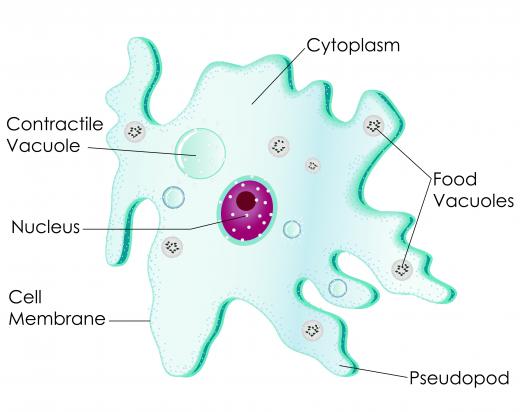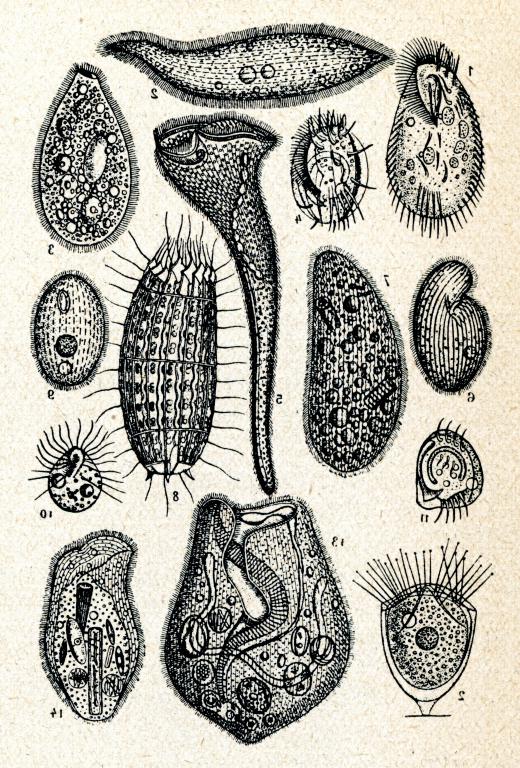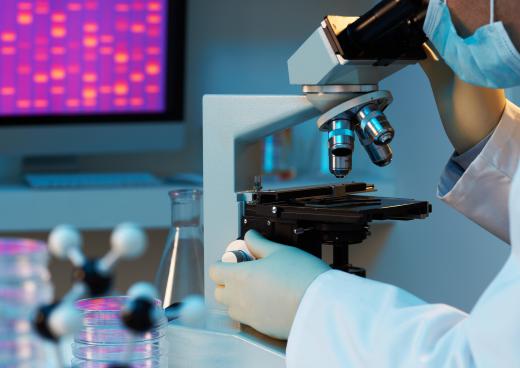What is an Amoeba?
 Michael Anissimov
Michael Anissimov
An amoeba is a type of unicellular organism usually found in water around decaying vegetation, in wet soil and in animals such as humans. It is relatively advanced, and can extend and retract blob-like arms called pseudopodia, which it can use to grasp food particles and to propel itself through microscopic terrain. The name “amoeba” can mean a particular genus of microorganism or any member of a large family of similar life forms. Although most types are harmless, a few can cause serious diseases in humans.
Protists

These organisms are types of protist, which is a group of simple life forms that are neither plant nor animal. The majority are microscopic, but some species are large enough to be visible to the naked eye. Amoeba proteus is the best-known species, and it measures around 0.028 inches (0.7mm), which is just visible. Some species can reach 0.1 inch (about 3 millimeters) or more in diameter. It is thought that the German naturalist August von Rosenhof was the first to observe these microorganisms in 1757, using an early microscope.
Structure

It is easy to study amoebas because they are relatively large and almost transparent. A basic light microscope can therefore reveal their internal structure and organs. The organism’s mobility and complexity makes it much more interesting to study than more simplistic protists. Scientists frequently use the amoeba for testing and observation, calling it a “model organism.”

An amoeba consists of a thin, flexible cell membrane containing a fluid called cytoplasm and various organs. The nucleus contains the genetic material. The contractile vacuole is used to regulate the amount of water in the cell, and this important organ can absorb water from the cytoplasm and expel it from the cell via the membrane. Food vacuoles are used to store and digest food that the amoeba has absorbed.
Habits and Life-Cycle

Many species of amoeba are found in fresh water, usually in mud at the bottom of pools or among rotting vegetation. Others live in the human digestive system. These include ones that can cause disease, but the majority simply live on food in the intestine without causing any problems. Certain types live on the skin, feeding on dead skin cells.
Amoebas use their pseudopodia for mobility and to obtain food. They can use these extensions to engulf small particles or smaller organisms and incorporate them into the cell, where they are digested. Most species feed on tiny pieces of organic matter and on other microorganisms, such as bacteria. A few are parasites that devour the cells of the host animal.

Depending on the salt content of the water where the organism is found, it will shrink or bloat in an attempt to equalize its density with that of its surroundings. If one is placed in water that contains no salt at all, it may swell so much that it bursts. When an amoeba encounters harsh conditions, such as drought or low temperatures, it can shrink and surround itself with a hard, protective coating. This is known as a cyst. It can exist for long periods in this state until conditions improve, but may not survive indefinitely.
Amoebas reproduce asexually by dividing into two “daughter” cells. The nucleus divides first, forming two genetically identical nuclei, a complex process known as mitosis. The organism then splits into two separate cells, each containing a nucleus, a process called cytokinesis.
Amoebas and Disease
Some amoebas can cause disease in humans, the best known being amoebic dysentery, or amoebiasis, caused by the organism Entamoeba histolytica. It is transmitted through water contaminated by sewage. Humans can be exposed to it by eating food that has come into contact with contaminated water and not been properly washed. The organism attacks the intestine, causing pain and diarrhea. The disease is very unpleasant and can be serious, but it is treatable.
Primary amoebic meningoencephalitis (PAM) is an extremely serious, but fortunately very rare, brain disease caused by an organism called Naegleria fowleri, sometimes called the “brain-eating” amoeba. The infection is almost always fatal. The organism lives in warm lakes and pools in many parts of the world where the water temperature is high enough, including the southern states of the US and Australia.
People swimming or playing in water containing the organism are at risk of infection. It enters the body via the nostrils, migrating to the brain, where it consumes cells, causing damage to brain tissue and inflammation. The disease is best prevented by avoiding likely habitats such as still, warm pools or by wearing nose plugs if swimming in such areas.
Observing Amoebas
For anyone with a microscope, these microorganisms make a fascinating subject for viewing. They are sometimes hard to find, however. One way to obtain living specimens is to use a jar to skim the top layer of mud from the bottom of a pond. Another method is to take a sample of pond water, including some plants, and place a microscope slide cover slip on the surface, so that it floats. After a day or so, bacteria will attach themselves to the lower surface, attracting tiny predators, including amoebas.
AS FEATURED ON:
AS FEATURED ON:















Discussion Comments
What pressure can an amoeba handle?
@post #3: 220-740 μm (micrometres).
Which are the useful and which are the harmful amoeba?
Not Binary Fission: Amoebae, like other single-celled eukaryotic organisms, reproduce asexually via mitosis and cytokinesis, not to be confused with binary fission, which is how prokaryotes (bacteria) reproduce.
It says brief and straight forward, also how are humans so different from animals again? I missed that biology class.
Response to comment #8: There is no such thing as an 'animal species'! There is an animal kingdom and the species Homo sapien is part of that kingdom.
Next time check your basic classification before putting someone else's work down.
And animals such as humans? Last time i checked humans and animals were two totally different species.
they do give you some good information but it is not enough and not totally explained.
Apart from the nucleus, food vacuole and contractile vacuole; what other organelles can be found in an amoeba?
I came here to get more information about the types of ameoba that can kill you if you swim in dirty water areas, but this is more skim the surface reading material :(
What are the structures and functions of amoebas?
How big are ameobas?
they don't have really that much information
they need a little bit more
and i prefer details about where the come from
and what they eat and what they do when the weather changes. things like that........
Post your comments